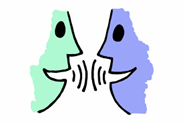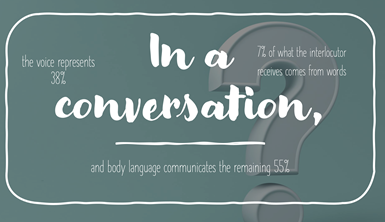Content begins here
Contenido de la página principal
Pulsa para colapsar
On-site communication
Introduction
Communication between people is the exchange of ideas, information, opinions or emotions that can be realized between two or more people.The reasons for its importance are multiple, starting because we are social beings and we need the closeness of other human beings.
This communication can take place in different ways: oral, gestural or written, and we will talk about this in the next lessons. But let's start with the most important communication: face-to-face communication.

Face-to face- communication is 34% more successful than an email
According to research from the University of Ontario, face-to-face communication is 34 times more successful than email, and this is because the tone of voice or the look, that is, the elements of non-verbal communication, persuade much more to the interlocutor than the message itself.

Following the Albert Mehrabian “7-38-55 rule”, in a conversation: 7% of what the interlocutor receives come from words, the voice represents 38% and body language communicates the remaining 55%.
Once this lesson is completed and approved, learners will be able to:
-
Differentiate the basic elements of communication.
-
Know the main benefits of on site communication.
In this lesson, we will learn why face to face communication has more impact than other forms of communication and get a first introduction to the importance of non-verbal elements of communication.
What are the advantages of on-site communication?
Face to face communication has different advantages over other forms of communication:
-
There is physical contact: This can help us feel better during the conversation, since physical contact activates physiological mechanisms that help our emotional well-being.
-
We have non-verbal communication: As we have seen, most of the emotional information is communicated with the body and not with words. Reading a text we cannot know if a person is okay even if they tell you, with gestures and expressions we can be more sure if that is true.
-
We pay more attention: If we are face to face, we pay more attention and avoid distractions.
-
We avoid misinterpretations: In writing may be lost or what is read may be misinterpreted.
-
Strengthens our bonds:Face-to-face communication creates bonds that help to establish affective bonds and provides security.
-
We expand our ability to communicate: it is easier to write on a screen to show emotions than to write in person. But by doing it in person we work on our ability to communicate more effectively.
Learning about communication
The elements of communication
For good communication, it is always important to wait for the interlocutor's response to the message transmitted by us. This mode of communication allows us to understand to what extent the one we are communicating with has understood what we tried to communicate to him/her, and if we notice that our message was not fully understood, we can eventually send the same message in another form. This time wait for the answer, too.
The levels at which the communication takes place
It is quite easy for us to talk when we have had similar experiences with those we communicate with. For this reason, sometimes we feel free to say certain things, other times we have the impression that it is better to just keep for ourselves certain things we know about ourselves, without wishing to share them with others. And sometimes our simple behaviour leaves the others to understand what we do not say in words.
Types of communication
In our group of friends, or even when we make new friends, when we notice that others have gone through experiences similar to ours, we feel much better, and we connect through open communication. Thus, it is much easier for us to talk about us or about events that we have never told, precisely because we feel fully understood by this group/team.
Elements that cancel communication
Regardless of whether we are in a work team or with a group of friends, we do not feel free to express our opinions if they are frequently criticized or not taken into consideration. Also, we feel marginalized when our opinions are misunderstood and even used against us easily.
Communication pathways: language
It is known that our body does not lie, for this reason, we can closely follow the body traits and gestures of those with whom we communicate, and, in this way, we can better understand if what is transmitted to us is consistent with what our interlocutor thinks.
Communicate in a creative relationship
I feel that I can ask for the help of a colleague or friend without fear and being honest about my needs. In this way, the other should feel free to give me his help or not. And I feel free to accept the refusal positively, without feeling frustrated because of that refusal. This shows me that I know who I am, that I do not expect each other to agree with me, and that we accept the freedom of being, of each one of us.
Colour in communication
Especially in meetings with foreign business partners or with my friends from abroad, I consider their cultural differences and cultural habits through the way I dress and the colours I use when meeting with them.
Conclusion
“Only when two people look directly at each other is there a real basis for communication”
Our expressiveness and posture communicate much more than our words, and it is for this reason that face-to-face communication has so much power. Our body provides a series of emotional information so important that it allows us to judge and classify at first glance. We assimilate what we see and what this makes us feel predisposes us, either positively or negatively.
In the following lesson, we will go deeper into the different parts of communication, and other skills related to active listening, empathy etc.
Video and PDF presentationPulsa para colapsar
The following video explains the content of this lesson and shows some examples:
Video T1.L1. On site communication
Here you have the content of the video in pdf in case you need to use it in your classroom:
Lesson contents in PDFPulsa para colapsar
Here you have the contents of the lesson in PDF:

